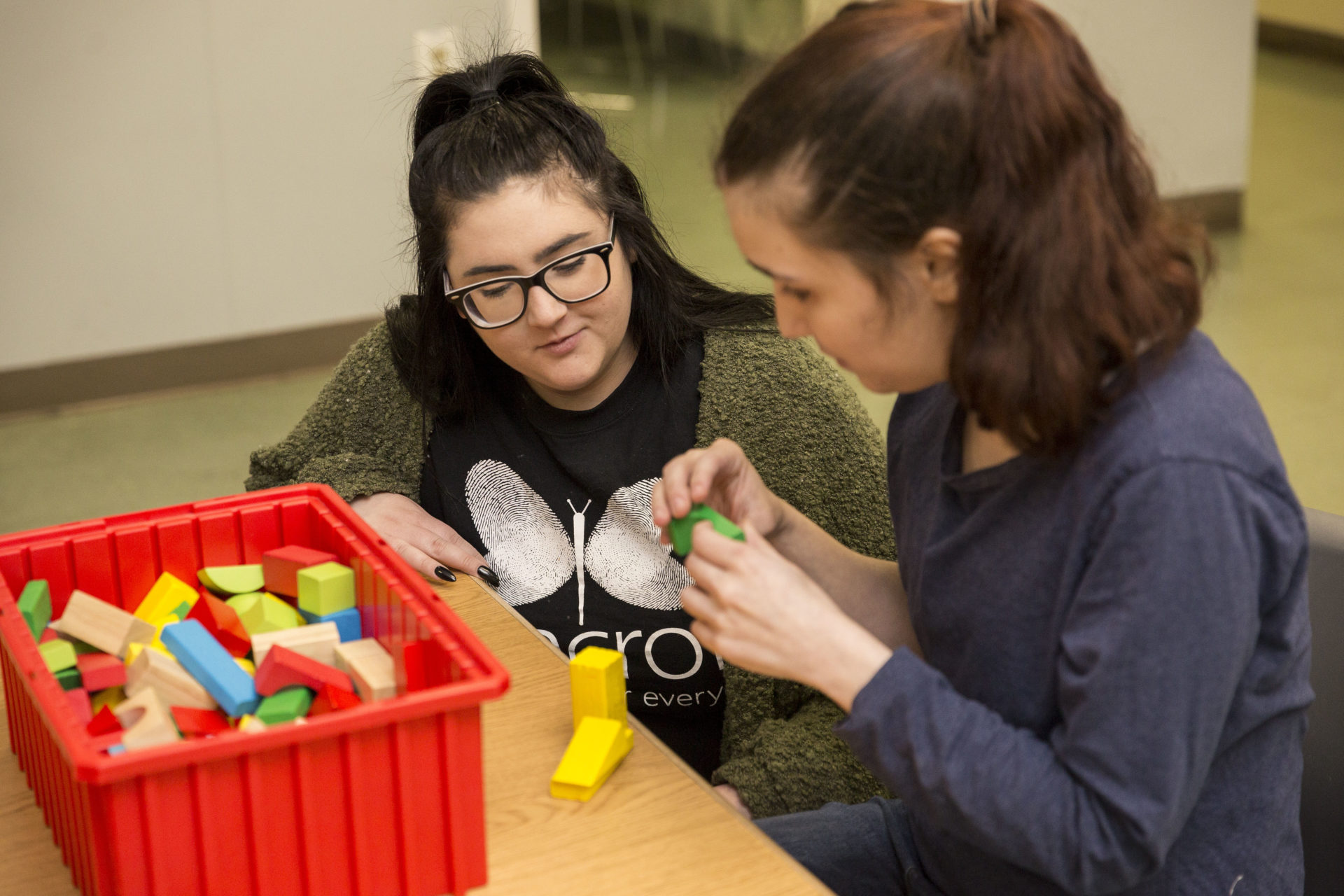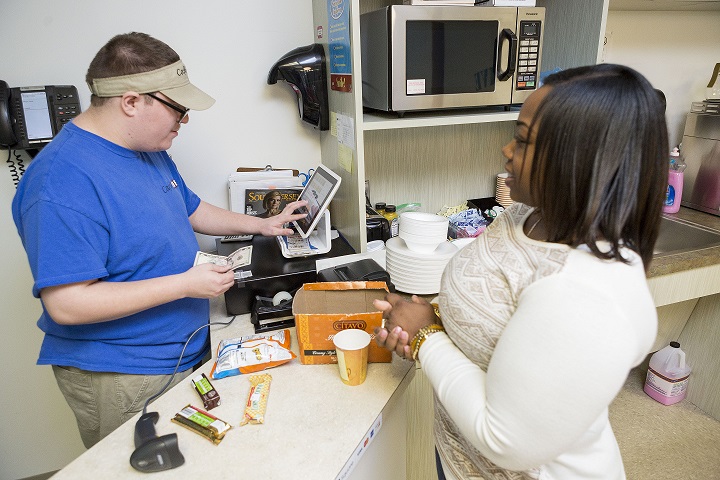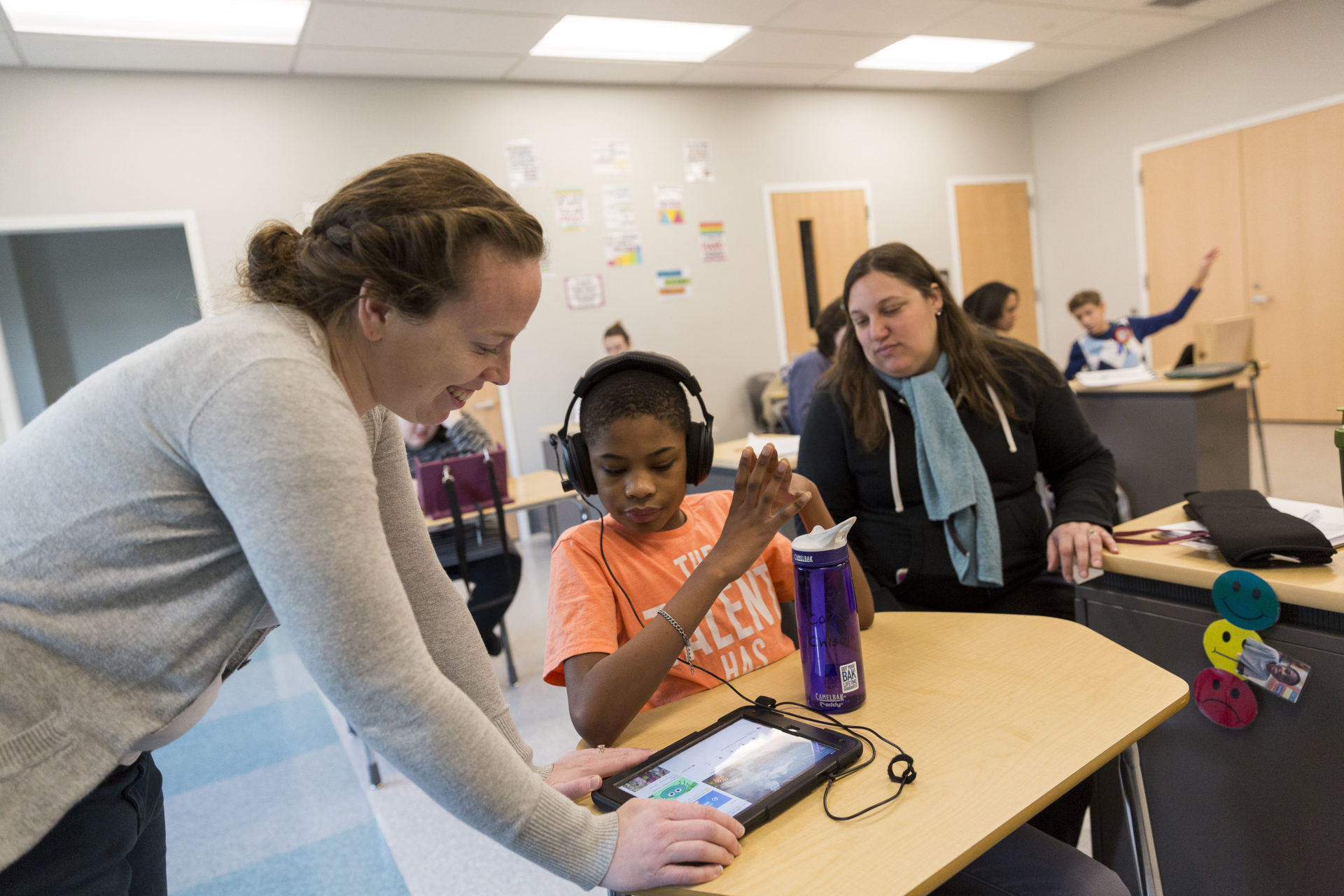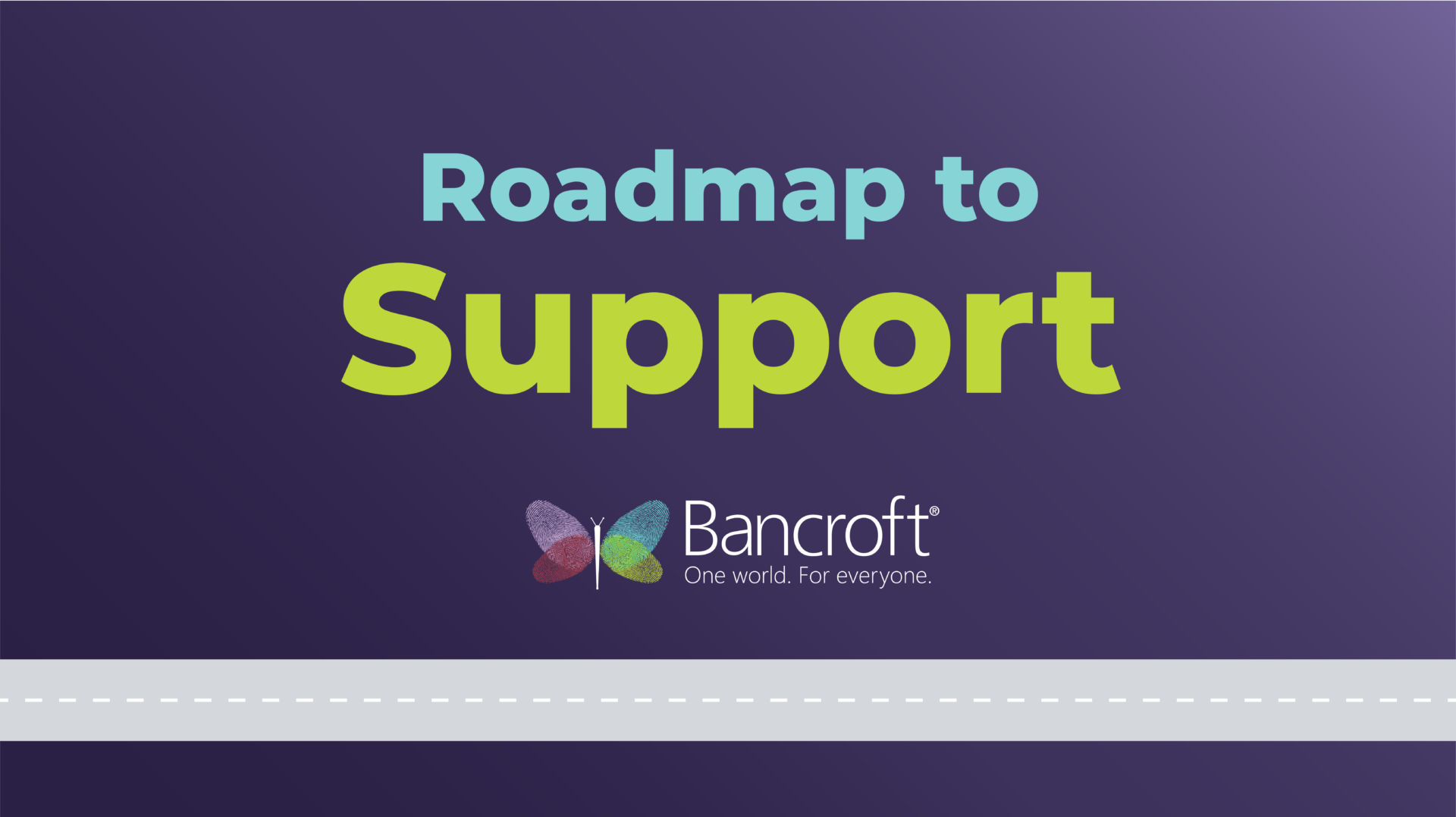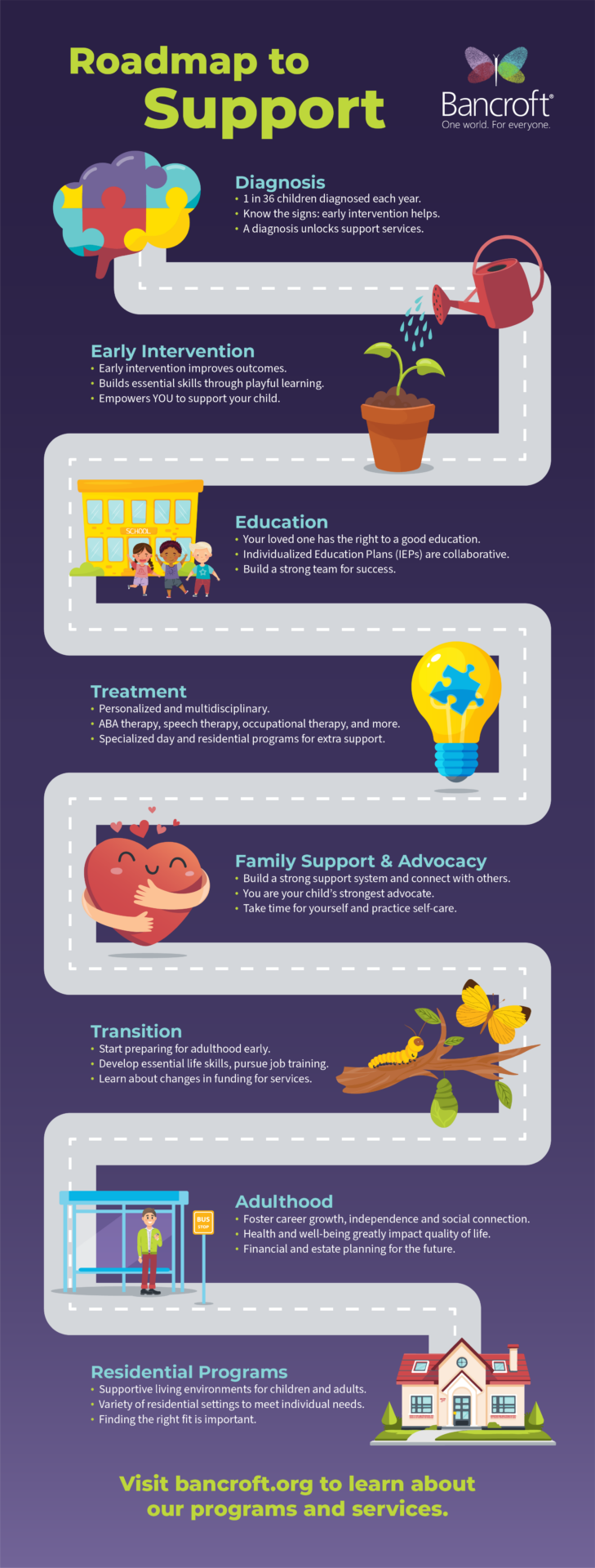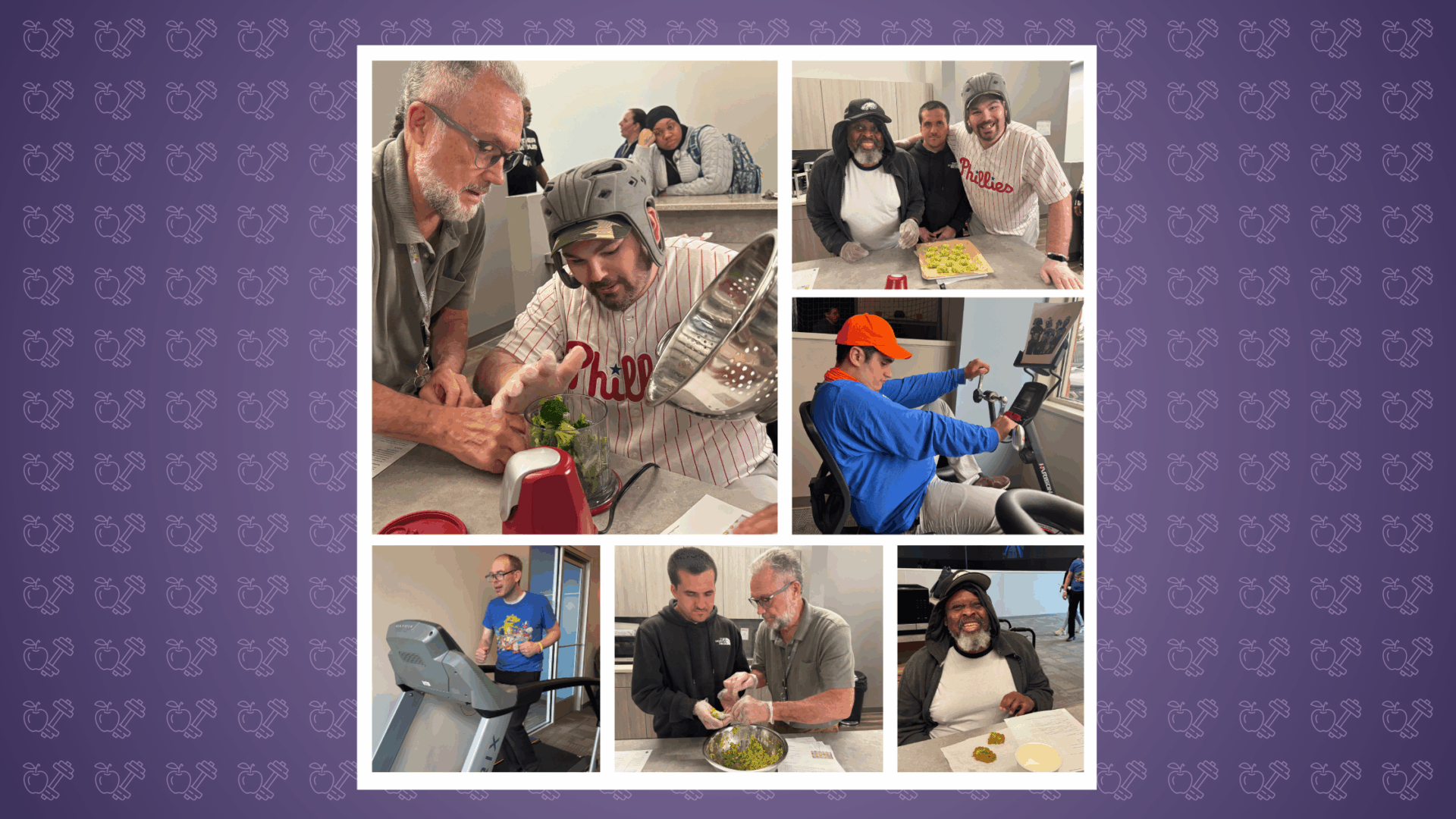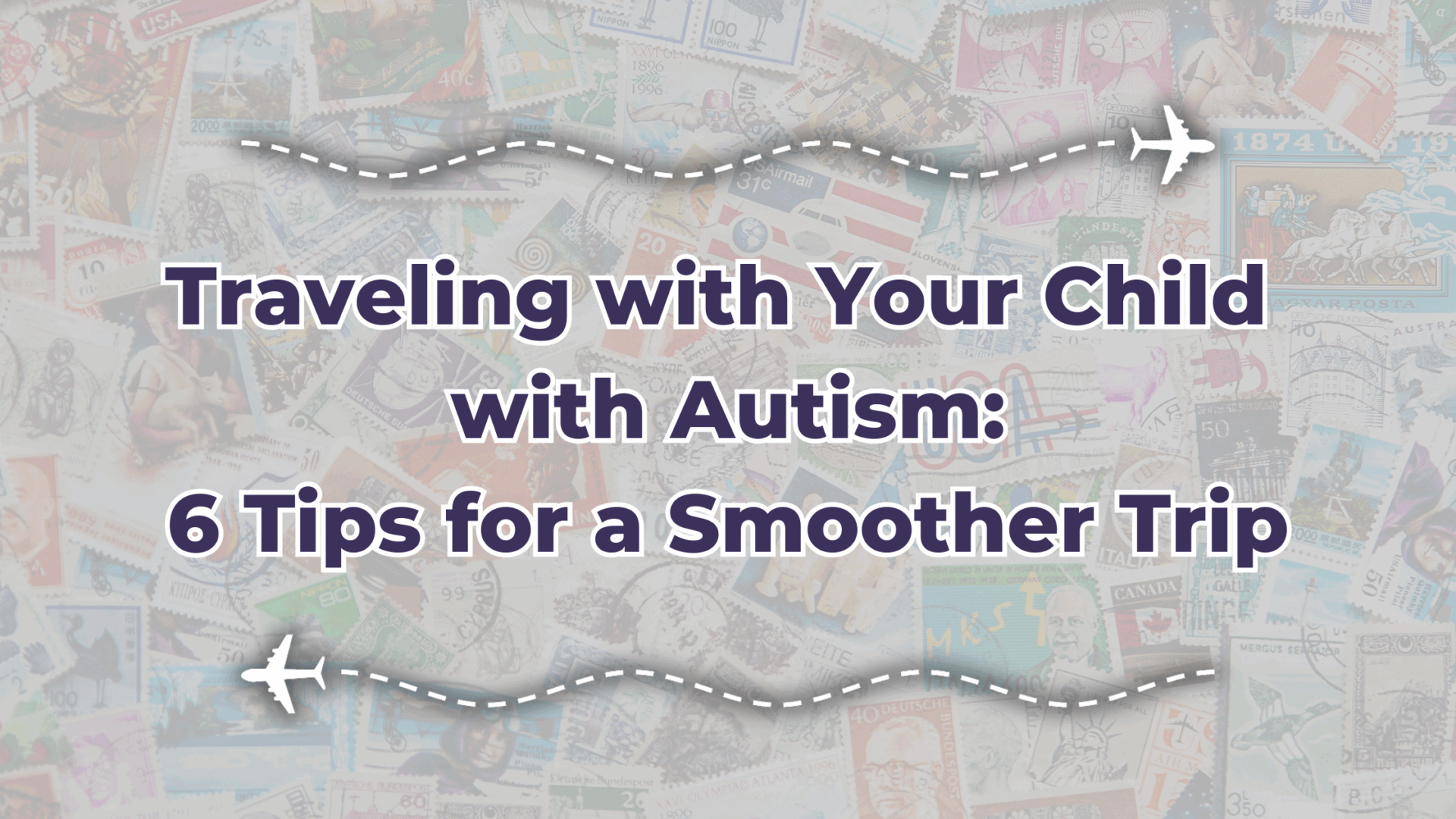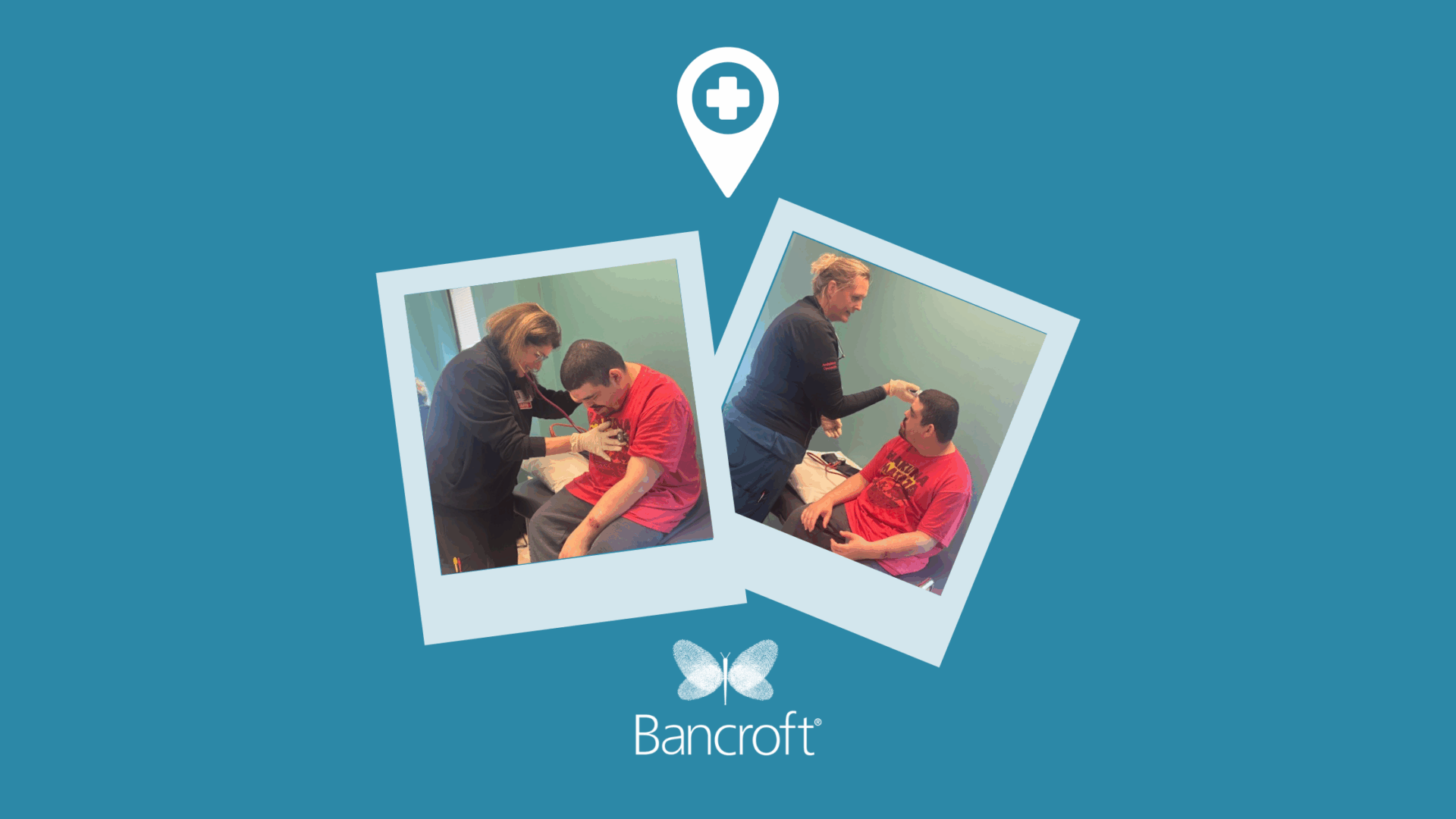Caring for a child with autism can be challenging, scary and confusing.
As a parent, you constantly worry whether you’re doing the right thing, making the best decision, or going down the right path. There is a common saying in the autism community: “If you know one person with autism, you know one person with autism.”
In other words, each person with autism is completely unique. There are no cookie-cutter approaches or generalizations to be made. Your journey with your loved one will be uniquely its own and this can make you feel very alone.
Take heart. You’re definitely not alone.
1 in 36 children are diagnosed each year with autism. That means 1 in 36 families are going through a similar experience. With the rising prevalence of autism, the amount of information on how to navigate this journey can sometimes make your head spin. That’s where roadmaps like this come in handy.
Our hope is that you use this roadmap as a compass; something to come back to every once in a while to help get your bearings when it all seems like too much; a guide to lead you through the phases and stages of caring for your loved one with autism.
Below you will find our Roadmap to Support printable graphic. In the article that follows, we dive deeper into each stop on the map.
For a printable PDF of the infographic, click here. Continue reading this article for more detailed information about the destinations, as well as links to helpful resources.
1. Diagnosis: A Stepping Stone, Not a Stumbling Block
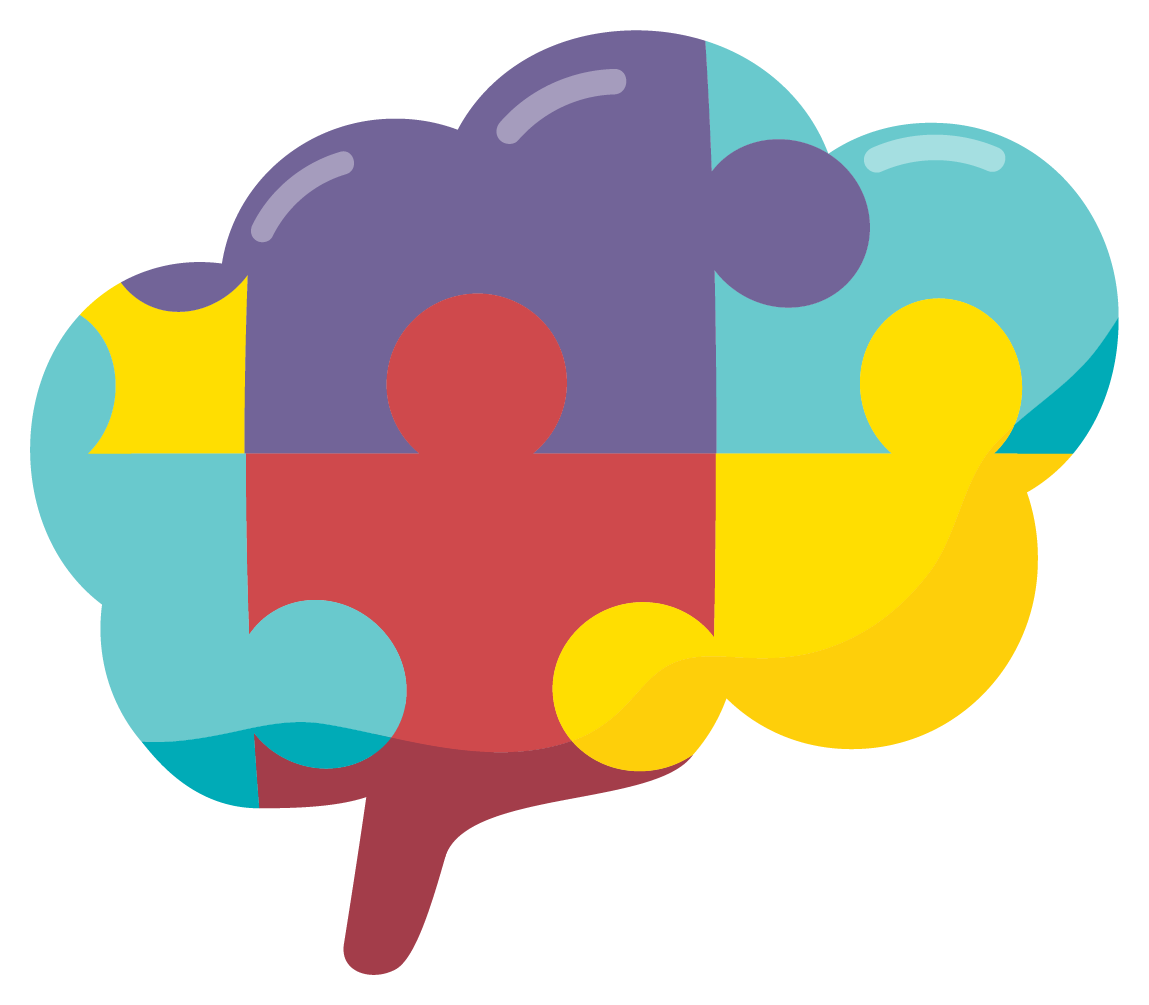
Receiving a diagnosis of autism spectrum disorder (ASD) for your child can be an emotionally charged experience. It’s natural to have questions, concerns, even fear. But here’s what’s important to remember: a diagnosis isn’t a roadblock, it’s a stepping stone. It’s what opens the doors to all the supports and services that will help your child realize their best life.
Knowing the Signs: Early Detection Makes a Difference
If you have concerns about your child’s development, especially in the areas of communication and social interaction, familiarizing yourself with some common signs of autism can be helpful. It’s important to remember that these signs can vary greatly, and a diagnosis should always be made by a qualified professional. However, some early indicators might include:
- Social interaction: lack of eye contact; doesn’t smile back or respond to play; prefers solitary play
- Communication: speech delays; echolalia (repeating words or phrases); difficulty expressing themselves or their needs/wants
- Repetitive behaviors: repetitive movements like hand flapping, rocking, or lining up toys; inflexibility to routines or changes in schedule; self-injurious behavior like head banging
- Sensory issues: extreme sensitivity to smells, sounds, and textures; sensory-seeking behavior (like rubbing their face on certain textures)
For a more extensive list of possible signs and symptoms, read our resource article, What is Autism? Another great resource is the CDC’s milestone tracker, also available as a free app.
What to Expect During a Diagnosis
Autism spectrum disorder must be formally diagnosed in order to access services. Whether you notice signs yourself or your pediatrician picks up on some red flags during your child’s well visit, the first step is to schedule an appointment for a diagnostic assessment.
No single test can diagnose autism. Instead, the assessment utilizes multiple sources of information. The evaluation process might involve:
- Detailed interviews with you about your child’s development and medical history.
- Observations of your child’s play and social interactions.
- Standardized assessments to evaluate your child’s skills and abilities.
- Rating scales completed by the child’s caregiver(s)
There are various types of professionals that can make a diagnosis of autism. These include developmental pediatricians, child psychologists, neuropsychologists, social workers, speech-language pathologists, occupational therapists, or other specialists with expertise in identifying autism spectrum disorders.
Diagnosis Opens Doors to Support and Resources
It’s important to remember that autism is a spectrum. Some individuals will require minimal support while others will need 24/7 support. The amount of support your child needs may fluctuate as your child changes and grows. Wherever your loved one falls on the spectrum, a diagnosis opens up a world of support to help them realize their best life.
Early intervention programs, specialized therapies, and educational opportunities become accessible once you have a diagnosis. It empowers you to connect with a team of professionals who can guide you on this path.
You’re Not Alone
This is the time to build your support team. You cannot do this all by yourself. Your child will need other professionals and mentors on their side. Seek support right away, for yourself and for your loved one. The better your mental health and outlook is, the better you can support your child.
2. Early Intervention: Giving Your Child the Best Start
Imagine your child as a tiny little seed, brimming with potential. Early intervention is like the sunshine, water and fertile soil that nourishes that potential. It’s a crucial first step on the autism journey.

Early Intervention Can Significantly Improve Outcomes
Research overwhelmingly supports the benefits of early intervention for children with autism. This is because the brain is most receptive to learning and development during the early years. Early intervention capitalizes on this critical window of opportunity, laying a strong foundation for future growth.
Under the IDEA Act, children under 3 at risk for developmental delays may be eligible for services. Services are typically provided through your state’s early intervention program once your child has been evaluated and a diagnosis has been made. Typically, your child will be assigned a case manager to help facilitate services and answer your questions. Here’s a state by state guide to early intervention.
Building Essential Skills Through Playful Learning
Early intervention programs are designed to address your child’s unique needs and challenges in a fun and engaging way – play! Depending on your child, these programs could include:
- Speech therapy: to improve communication skills, including expressive and receptive language.
- Occupational therapy: to address sensory sensitivities, develop fine and gross motor skills, and promote daily living skills.
- Applied Behavior Analysis (ABA therapy): to focus on core skills like attention, social interaction, and positive behavior reinforcement.
Your child’s team will work together to create the best early intervention program for your child.
Empowering You on the Journey
Early intervention isn’t just about therapy sessions for your child. It also focuses on empowering you and the rest of your family, providing valuable guidance, training and support. Your child will spend a certain amount of hours each week with their therapists, but the reinforcement of what they learn comes from you. This early intervention training empowers your ability to help your child, providing a foundation for success.
3. Education: Every Child Included
A child’s education is fundamental to their ability to flourish later in life. Every child deserves the opportunity to learn and grow in a supportive environment. As a parent or caregiver, it’s important to know your child’s rights and to use your voice to advocate for a quality education for your loved one.

Your Child Has the Right to a Good Education
By law, school districts must provide a Free Appropriate Public Education (FAPE) to all children, including those with autism, from ages 3 to 21 (exact age range can vary by state). This includes not only core curriculum but also related services such as speech therapy, occupational therapy, and Applied Behavior Analysis (ABA) to address individual needs. This comprehensive approach empowers your child to thrive at school and reach their full potential.
Tailored Learning: IEPs and 504s
- Individualized Education Programs (IEPs): These customized learning plans outline specific goals, accommodations (like extended time for tests or preferential seating), and modifications (like alternative assignments) tailored to your child’s unique learning style and needs. IEPs are legally binding documents and are created collaboratively with parents, teachers, and specialists. Learn more about IEPs in our article, What to Expect: Your Child’s IEP Meeting.
- 504 Plans: These plans provide accommodations for students with disabilities without changing the core curriculum. For example, a 504 plan might allow for a student to use a recording device in class or receive additional breaks throughout the day.
Building a Strong Team for Success
Collaboration between parents, educators, and therapists is essential for your child’s educational journey. It’s important to ensure that there is open communication between all stakeholders.
Unless your child is in a residential setting, their therapists, teachers and other supports don’t follow them home. You have insight and wisdom that they don’t possess. It’s your love that fuels their growth and champions their potential. Make your voice heard too. Share your concerns, opinions, and ideas. Never underestimate the role you play in your child’s development.
4. Treatment: Personalized and Multidisciplinary
We’ve said it before, but it’s worth saying again. Every person with autism is unique. There is no one-size-fits-all approach. Furthermore, each individual grows and changes over time. Their treatment must change with them.
The one constant in treatment? It’s always changing to fit the current needs of your loved one, helping them navigate their present and prepare for their future.

The Importance of a Multidisciplinary Team Approach
A multidisciplinary team approach, coordinating the efforts of various specialists, is considered the gold standard in autism treatment. This team might include doctors, developmental specialists, therapists, and educators. Working together, they can create a comprehensive treatment plan to address your child’s medical, developmental, educational, mental, and social-emotional needs.
Exploring Therapy Options:
- Applied Behavior Analysis (ABA therapy): “Applied behavior analysis is the application of the science of behavior analysis to socially significant behaviors,” says Dr. Tracy Kettering, Ph.D., Director of the ABA Center of Excellence at Bancroft. “When applied to autism, ABA treatments utilize the science to increase appropriate behaviors, such as language or social skills, or to decrease inappropriate behaviors, such as tantrums and aggression.” Learn more in Tracy’s article, Exploring Applied Behavioral Analysis (ABA) Therapy.
- Speech-Language Therapy: This therapy helps improve communication skills, both verbal and nonverbal. It can address speech delays, social communication challenges, and language processing difficulties. It can also include training and incorporation of Augmentative and Alternative Communication (AAC) devices.
- Occupational Therapy (OT): OT helps individuals with autism develop the skills they need to complete daily tasks and participate in age-appropriate activities. It can also address sensory processing issues, which are common in autism.
Additionally, there are supportive therapies and programs that help support success and growth. These include nutritional therapy / support, physical therapy or exercise, and educational therapy.
Treatment for Profound Autism
Some children and adults with autism require 24/7 support and care that is more than caregivers can handle on their own. In these instances, there are day programs and residential programs that can help. Here at Bancroft, we have residential programs, Lindens Neurobehavioral for children, and Lakeside Campus for adults.
5. Family Support & Advocacy: You're Not Alone
It’s easy to feel like you’re on an island, dealing with this all by yourself. But there are so many families who are going through a similar journey. Reach out and find support. And don’t forget self-care! Here are some tips to help:

Building a Strong Support System
Autism can impact the whole family, and having a strong support system is essential. It helps to connect with other families who “get it,” those who understand the unique joys and challenges of your journey. Simply knowing you’re not alone can make a big difference.
Support groups can provide a safe space to share your experiences, ask questions, and find emotional support. You’ll also gain practical advice from families who have navigated similar challenges, offering valuable tips and strategies you can implement in your own life.
Advocating for Your Loved One
Advocacy has many different layers, and they’re all important. There’s advocating for your loved one on a personal level – with their team, their school system, and other direct supports. Then, there’s advocacy on the local and state level to help ensure your loved one has access to the services they need to thrive. Finally, there’s national advocacy that petitions our federal government on behalf of individuals with autism.
Here’s how you can become your loved one’s strongest advocate:
- Become an expert on your child’s needs: The more you know about their strengths, challenges, and learning style, the more effectively you can advocate for them in educational settings, doctor’s appointments, and other situations.
- Learn about your child’s rights and available resources: Organizations like Autism Speaks and Autism New Jersey offer training programs and information to help you navigate the system and ensure your child receives the support they deserve.
- Join local and national advocacy groups: Connecting with advocacy organizations can empower you with knowledge, resources, and a network of support. Through them you can use your voice to advocate for policies that help your loved one. Here are a few resources to help you get started:
- If you live in New Jersey: https://njacp.org/advocacy/
- If you live in Pennsylvania: https://www.par.net/action-center
- If you live in Delaware: https://abilitynetworkde.org/public-policy-overview/
- For federal issues: https://www.ancor.org/amplifier/
- Special education advocacy: https://www.asah.org/generating-and-sharing-resources/
Respite Care: Taking Time for Yourself
Caring for a loved one with autism can be challenging. It can take a toll on your own physical, mental and emotional health. It’s not selfish to take time for yourself. If you want to do your best for your loved one, you have to practice self-care.
Respite services provide a temporary break, allowing you time to recharge, focus on your own well-being, and return to your caregiving role feeling refreshed and energized. Reach out to local and state support systems to find respite services. If you live in New Jersey, visit Autism New Jersey to learn more.
6. Transition: Preparing for Adulthood

Graduation marks the end of support and services through the school system. Many parents worry, “What will my child do once school ends? Will they be able to thrive as adults? Where can I find the supports and services my child needs? What about financial assistance?”
An uncertain future can cause anxiety and stress for everyone, which is why transition planning is so important.
Charting a Course for Success
- Start Early: Transition planning ideally begins in the teenage years and continues to evolve as your child grows. Work collaboratively with your child’s team to develop a roadmap for their future, focusing on their individual goals, strengths, and needs.
- Essential Life Skills: Developing essential life skills like budgeting, cooking, personal hygiene, and using public transportation empowers young adults with autism to navigate daily life with confidence.
- Career Exploration: Explore various career paths based on your child’s interests and strengths.
- Vocational Training: Set your child up for success with job skills and vocational training.
- Social/Emotional Skills: Continue to develop social and emotional skills. They are paramount to your child’s success as an adult.
- Funding and Financial Assistance: Adult services for autism have different funding sources than children services. Start exploring your options early so there’s no large gap in care.
For more information about successful transition planning, read our article, Beyond Graduation: Transition Planning for Children with Autism.
7. Adulthood: A World of Possibilities
Adulthood is the longest phase of your loved one’s life. There are endless possibilities of what it can look like. The most important thing is to help foster a fulfilling life for your loved one with meaning, purpose, connection, and joy. No matter where they fall on the spectrum, they can realize their best life with the right support system and services.

Building a Fulfilling Life
- Employment and Career Opportunities: Many adults with autism are able to thrive in supportive work environments. Others may not be able to work in the traditional sense, but can find joy and meaning in volunteer work. Another option is adult day programs, which provide continued functional learning through structured activities, community inclusion, and a variety of therapeutic supports.
- Independent Living: For some adults with autism, independent living is a goal, while others may require ongoing support. There are assisted living options as well as group homes that have 24/7 care and support. Wherever your loved one falls on the spectrum, you can always foster independence, which helps them feel more empowered and free.
- Relationships and Social Life: Everyone needs friends. Your loved one with autism is no different. There are groups they can belong to and activities they can join to help foster friendship and connection.
Health and Well-Being Matter
Just like everyone else, an adult with autism’s quality of life is directly impacted by their health and well-being: physically, emotionally and mentally. Here are some key areas to focus on:
- Physical Health: Maintaining a healthy lifestyle through regular exercise, balanced nutrition, and preventive healthcare screenings is essential for overall well-being.
- Emotional and Mental Health: Adults with autism may experience anxiety, depression, or other mental health challenges. Seeking professional help and developing healthy coping mechanisms is crucial.
- Sensory Sensitivities: Understanding and managing sensory sensitivities can significantly improve an adult’s quality of life. Techniques like noise-canceling headphones or creating a calming sensory space at home can be helpful.
Planning for a Secure Future: Peace of Mind for Your Family
As parents and caregivers, it’s natural to want to ensure your loved ones are well-cared for, especially as you age. For families with a member on the autism spectrum, planning for the future is particularly important. This planning can encompass several aspects:
- Financial and Estate Planning: Creating a will, establishing trusts, and exploring government benefits can help ensure your loved one’s financial security in the long run. (Read our Essential Guide to Special Needs Estate Planning to learn more.)
- Residential Support Options: Considering long-term residential care options, such as those offered by our programs at Bancroft, provides peace of mind knowing your loved one will have a safe and supportive environment throughout their life journey.
- Communication and Collaboration: Openly discussing your loved one’s future needs and preferences with them, along with other professionals and family members is important. This collaborative approach ensures everyone is on the same page and your loved one’s wishes are taken into account.
8. Residential Programs: Tailored Living Options for Individuals with Autism

At various stages of life, individuals with autism may require different levels of support. Residential programs offer a safe and supportive living environment that caters to these evolving needs. Bancroft offers both adult residential programs and children residential programs for individuals with autism, ensuring a smooth transition throughout their developmental journey.
Exploring Options: A Variety of Residential Settings
The decision of where your loved one lives is a personal one. There’s a spectrum of residential program options available, each designed to provide the level of support your loved one needs to thrive. This can empower them to develop independence, social skills, and a sense of belonging. Here’s a brief overview of some common program types:
- Group Homes: These shared living arrangements typically house a small number of individuals and offer 24/7 supervision by trained professionals. Group homes provide a structured environment and assist with daily living activities, social interaction and skill development.
- Supported Living Arrangements: Supported living provides individuals with their own apartment or living space, while still offering regular support services. This could include assistance with meal preparation, housekeeping, medication management, or transportation. The level of support can be tailored to the individual’s needs.
- Independent Living with Support Services: For individuals who desire maximum independence, independent living programs offer support services on an as-needed basis. This might include assistance with budgeting, job coaching, or social skills development.
Planning for Long-Term Care
As parents and caregivers age, considering long-term care options for your loved one with autism provides peace of mind. Residential programs can offer a safe and secure environment throughout their life journey, ensuring their continued well-being. By understanding the available residential options, you can proactively plan for the future and choose a setting that fosters your loved one’s independence and growth for many years to come.
Finding the Right Fit
Choosing the most suitable residential program is a collaborative process. Here are some key steps:
- Understanding Your Loved One’s Needs: Evaluate your loved one’s current and future needs in terms of daily living skills, level of supervision, and social interaction.
- Exploring Program Options: Research residential programs in your area and their specific offerings. Consider factors like location, program philosophy, and the level of support provided.
- Open Communication: Discuss your loved one’s needs and preferences with program staff and involve them in the decision-making process whenever possible.
- Be Flexible: Your loved one’s needs will change over time and their living arrangements may need to change with them.
Resources to Help
Here is a list of resources that can help you and your loved one on this journey.
Autism Organizations
- Autism Speaks
- Autism Society
- Autism NJ (for those who live in NJ)
Helpful Resources, Toolkits, and Other Information
Final Thoughts
With this roadmap, we have explored the vast world of autism. Together, we’ve navigated the importance of early intervention, discovered treatment options, and emphasized the strength of family support and advocacy. We’ve charted a course for a smooth transition to adulthood, explored fulfilling career paths, and considered long-term residential options.
Throughout life’s journey with autism, however, there will be uncharted waters and unexpected currents. That’s true of every life journey. Remember, you are not alone. Reach out for support and get the help you need. Embrace your child’s unique individuality, celebrate the victories, big and small, and above all, enjoy the journey.

Bancroft offers a range of programs and resources that are designed to help children with autism unlock their potential and prepare for a bright future. We invite you to visit our Children’s Services page to learn more about how we can support your child on their journey to success.
We also offer programs for adults with autism and other intellectual and developmental disabilities including day and vocational programs, as well as residential services. Visit our Adult Services page to learn more.



